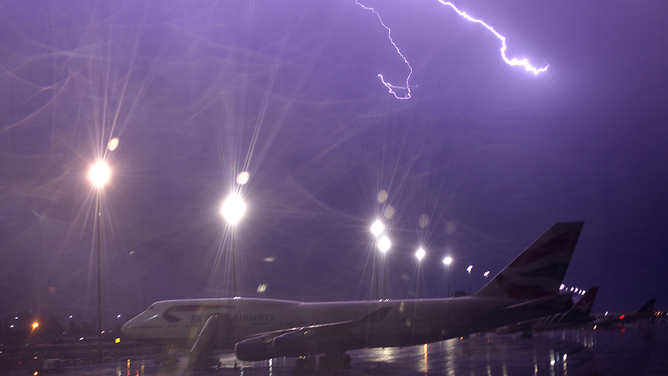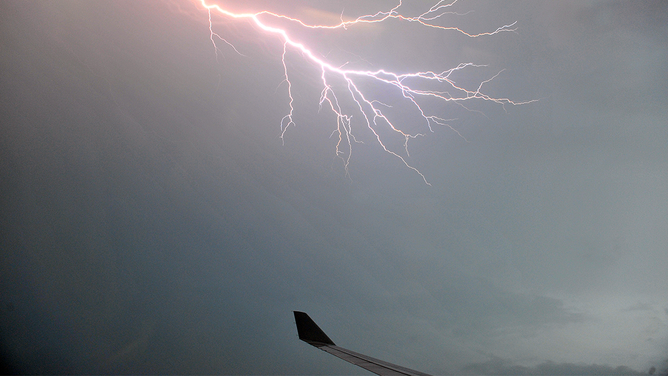Lightning strikes on airplanes can be scary – just ask Miley Cyrus
Airplane carrying singer Miley Cyrus forced to make an emergency landing after getting struck by lightning over South America on Tuesday
The thought of your airplane being struck by lightning while zooming through the sky at hundreds of miles per hour and thousands of feet in the air is terrifying – but it's not as dangerous as you think.
There are some instances, however, that could cause a pilot to decide to divert the aircraft after being struck.
HOW TO WATCH FOX WEATHER ON TV
That's the situation singer Miley Cyrus found herself in on Tuesday when her airplane needed to make an emergency landing in South America when en route to a concert in Paraguay.
In a post on Instagram, the international superstar shared a video of her airplane being struck by lightning while flying through a thunderstorm.
HERE'S WHAT CAUSES TURBULENCE AND WHY YOU SHOULDN'T BE AFRAID OF IT
"Our plane was caught in a major unexpected storm and struck by lightning," Cyrus said in the post. "My crew, band, friends and family who were traveling with me are safe after an emergency landing."
It's fairly common for commercial airplanes to be struck by lightning.
In fact, the National Weather Service says passenger planes are struck by lightning an average of once or twice every year.
But the last confirmed commercial airplane crash in the United States attributed to lightning occurred in 1967.
Pan American Flight 214 was headed to Philadelphia when it encountered thunderstorms.
A bolt of lightning hit it, and the aircraft exploded, crashing to the ground below in Maryland, killing everyone on board.
It was later determined that lightning had ignited fuel in one of the airplane's reserve tanks, which caused an explosion in the left wing and made the aircraft go out of control.
Since then, improvements have been made to prevent tragedies like Flight 214.
Commercial airplanes are now designed and built to have conducting paths throughout the aircraft to withstand the strike.
However, according to the NWS, smaller aircraft, like private planes and experimental aircraft, are not required to have those protections on board.
When is an airplane most likely to get struck by lightning?

Lightning strikes over a British Airways international flight at Johannesburg International airport on October 23, 2009 in Johannesburg, South Africa. Many flights were delayed after an electrical storm prevented flights from leaving or taking off.
(Dan Kitwood/Getty Images)
When an airplane is struck depends on several factors, according to aerospace company Boeing.
Geographical location is a big factor. For example, thunderstorms are fairly common during the year in Florida, but in areas along the West Coast, they don't occur as frequently, Boeing said.
The phase of the flight can also be a factor.
In general, most airplanes are struck by lightning when flying through clouds. So just like avoiding thunderstorms to stay away from turbulence, pilots avoid storms to prevent being struck.
The other phases of flight that has an increased risk of being hit by a bolt of lightning are during both climb and descent, usually between 5,000-15,000 feet.
Areas of the aircraft that are most likely to be hit include the wing tips, nose or rudder.
What happens when an airplane is struck by lightning?

Lightning is seen through the window of the Malaysian Airlines plane over the Kuala Lumpur city on November 29, 2010.
An airplane can essentially act as a lightning rod.
The bolt will initially strike one point, like the nose, and travel through the aircraft to an exit point, like the wing tip.
After that, the bolt will continue where it could hit the earth's surface.
Electrical systems on the airplane are built to withstand a lightning strike, but one of higher intensity can damage systems that rely on electricity like fuel valves, generators, power feeders and electrical distribution systems, according to Boeing.
When an airplane is hit, the pilot will determine whether it's safe for the flight to continue.
If not, the plane will divert to inspect the aircraft for damage and make repairs if necessary.
If the pilot determines that the aircraft is safe, it will continue to its final destination, where a full inspection will take place to ensure the plane is safe or if repairs are needed.